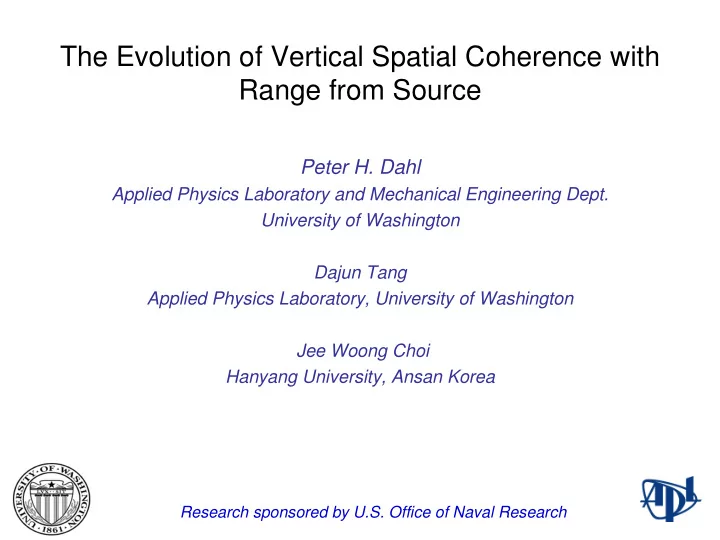

The Evolution of Vertical Spatial Coherence with Range from Source Peter H. Dahl Applied Physics Laboratory and Mechanical Engineering Dept. University of Washington Dajun Tang Applied Physics Laboratory, University of Washington Jee Woong Choi Hanyang University, Ansan Korea Research sponsored by U.S. Office of Naval Research
surface float 3-4 m water line 3 m hydrophone
Experimental site: off the New Jersey Continental Shelf, Water Depth 80 m Shallow Water 06 (SW06) August 2006 Moored Receiver Acoustic Source & Data Telemetry 0.1 - 10 km R/V Knorr m 2 5 30 and 40m 5 0 m 1.4 m VLA 80m
Moored Receiver Spatial coherence between (d) vertically-separated x channels based on N ping avg 0.2 m * xy Γ xy = 2 5 m 0.3 m y * * xx yy 5 0 m 4 receiver pairs and frequency (k) 0.9 m 6 combinations of kd
MEASUREMENT APPROACH Estimates of vertical spatial coherence made with FM and CW pulses •frequencies 3-18 kHz •BW << 1/channel impulse time, multi-paths are not separated but combined Each pulse separated by ~60 sec. Considerable averaging necessary to reduce both bias and variance. Computed from equations in Carter et al . (1973)
MEASUREMENT APPROACH Low values of coherence magnitude particularly susceptible to bias Several experimental sets combined over periods of order 60 min. is sufficient to reduce bias and variance to acceptable levels – especially important for lower magnitudes of coherence < ~0.3 For N~100 or more estimates, more tolerable bias and variance for low coherence magnitudes Computed from equations in Carter et al . (1973)
MODELING APPROACH RAM Parabolic Equation (Collins) modified to account for rough water-air impedance boundary (via approach of Thomson and Brooke, 2003) Generate 1-D cuts through a 2-D sea surface: Large surface wavelengths ( λ > 16 cm, |K| < 1) use directional information from nearby wave buoy estimates (Low Pass Sea Surface) Small surface wavelengths (|K| > 1) goes as 1/|K x | -3 equivalent to 1/|K| -4 in 2D (High Pass Sea Surface) Surface Realization = Low Pass + High Pass with wave number support up to K~ 30 Sound speed data taken when appropriate from with CTD casts made from the R/V Knorr, or derived from he WHOI temperature mooring (“Shark”)
Average air-sea conditions for 0830-1500 UTC. Wind speed 6 m/s +/- 1 m/s 0 WAVE DIRECTION FROM (deg) 160 o 220 o 100 APL-UW wave buoy 200 300 0.1 0.2 0.3 0.4 0.5 0.6 FREQUENCY (Hz) 0 10 2 /Hz wave buoy SPECTRAL DENSITY m -1 10 -2 10 0.12 Hz 0.34 Hz -3 10 0.1 0.2 0.3 0.4 0.5 0.6 U. Miami FREQUENCY (Hz) ASIS buoy
PE Field 10 kHz flat surface DEPTH (m) rough surface DEPTH (m) RANGE (m) mode stripping (Thorsos et al., 2004)
change c(z) with flat sea surface: poor agreement 1 0.5 Vertical Spatial Coherence ( Γ ) R=0.1 km 0 -0.5 -1 0 10 20 30 40 50 60 1 0.5 R=0.2 km 0 -0.5 -1 0 10 20 30 40 50 60 Normalized Vertical Separation (kd)
fixed c(z) with each new sea surface 1 0.5 Vertical Spatial Coherence ( Γ ) R=0.1 km 0 -0.5 -1 0 10 20 30 40 50 60 1 0.5 R=0.2 km 0 -0.5 -1 0 10 20 30 40 50 60 Normalized Vertical Separation (kd)
change c(z) with each new sea surface: better agreement with data 1 0.5 Vertical Spatial Coherence ( Γ ) R=0.1 km 0 -0.5 -1 0 10 20 30 40 50 60 1 0.5 R=0.2 km 0 -0.5 -1 0 10 20 30 40 50 60 Normalized Vertical Separation (kd)
1 R=0.1 km 0 Vertical Spatial Coherence ( Γ ) -1 0 10 20 30 40 50 60 1 R=0.2 km 0 -1 0 10 20 30 40 50 60 1 R=0.5 km 0 -1 0 10 20 30 40 50 60 1 R=1.0 km 0 -1 0 10 20 30 40 50 60 Normalized Vertical Separation (kd)
VLA depth 1 25 m R=1 km 50 m 0.5 Vertical Spatial Coherence ( Γ ) 0 0 10 20 30 40 50 60 1 0.5 R=2 km 0 0 10 20 30 40 50 60 1 R=4 km 0.5 0 0 10 20 30 40 50 60 1 R=8 km 0.5 0 0 10 20 30 40 50 60 Normalized Vertical Separation (kd)
VLA depth 1 25 m kd* = 4.7 R=1 km 50 m 0.5 Vertical Spatial Coherence ( Γ ) 0 0 10 20 30 40 50 60 1 kd* = 6.4 0.5 R=2 km 0 0 10 20 30 40 50 60 1 kd* = 9.4 R=4 km 0.5 0 0 10 20 30 40 50 60 1 kd* = 12.2 R=8 km 0.5 12.2 0 0 10 20 30 40 50 60 Normalized Vertical Separation (kd)
14 12 compare with P.W.Smith, 1976 kd * ~ R / D 10 8 kd* 6 4 region of oscillatory region of monotonic decay | Γ | (real & imaginary parts) of | Γ | (no imaginary part) 2 0 1 10 100 Range scaled by Depth
Notional Ideas on Vertical Coherence
Summary •Spatial coherence subject to significant bias, particularly at | Γ | < ~ 0.2 •Rough surface PE simulations compare well with observations (comparison only for ranges < 1 km ) •For short ranges (Range/Depth < 10) multipath | Γ | is highly oscillatory, (ray view point) • For long ranges (Range/Depth) > 10 multipath | Γ | becomes monotonic •Spatial coherence increases with range due to mode stripping: •short range: sea surface plays a strong role (modeled in this work) •longer range: ocean dynamical effects will dominate ( not modeled in this work) •Increasing spatial coherence with range has important implications in terms of modeling reverberation and signal processing gain
Recommend
More recommend